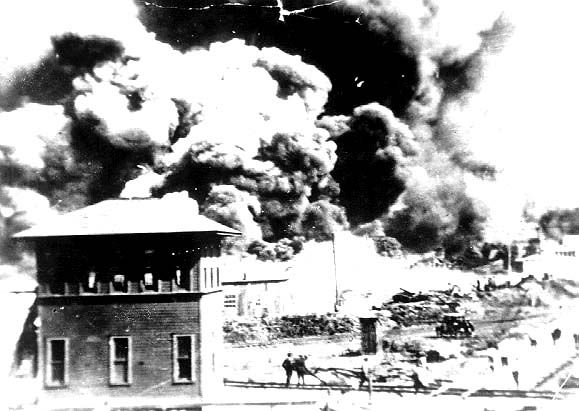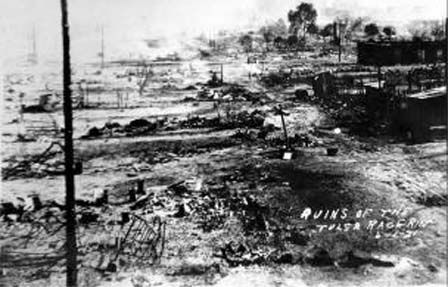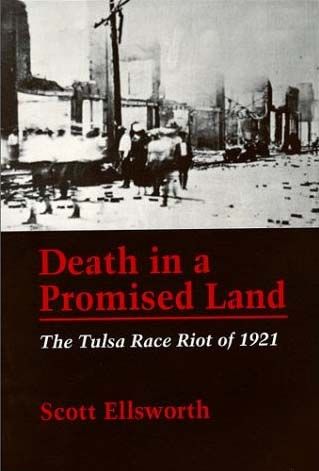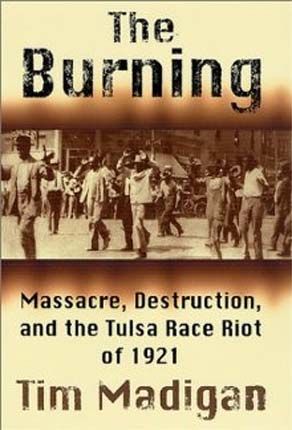
The Tulsa Massacre and the Destruction of Black Wall Street – May 31, 1921
Funny, but when I think of Oklahoma I don’t think of black folks.
I tend to think of the song from the Broadway show by Rodgers and Hammerstein, as a place “where the wind comes sweepin’ down the plain and the wavin’ wheat can sure smell sweet when the wind comes right behind the rain”.
I don’t think of the stench of burned bodies and burned out homes.
If I think a bit deeper and longer it was the place at the end of The Trail of Tears, or “Indian Territory”.
I certainly don’t associate Oklahoma or Tulsa with the largest massacre of African-Americans after the end of slavery. Nor – when I think of prosperous historical African-American communities would Tulsa come to mind – certainly Harlem, or DC, or Philadelphia, New Orleans or Chicago would be instant picks.
Black Wall Street? In Oklahoma?
Yes. It was there. And this week is the 90th anniversary of the lives and deaths of a people and a once thriving community.
Listen to the spoken word of Brother Arthur L. Farahkhan
Black Wall Street Massacre
Or to this feature piece done to mark the 75th anniversary on the Today Show, with Bryant Gumble.
I do not think of Tulsa as a place that had internment camps. Yet it did.
The devastation was complete. Greenwood was hit by what was like a human tornado. A white tornado.
ruins of Tulsa
As black Tulsans won their release from the various internment
centers, and returned to Greenwood, most discovered that they
no longer had homes any more (Courtesy Department of Special
Collections, McFarlin Library, University of Tulsa).
When I hear reports of the bombing of US civilians, I do not see a visual of Greenwood. I think of what happened in Philly to the folks from MOVE. Yet black residents of Tulsa were attacked – not just by roving mobs of whites and State Troopers – they were hit from the skies as well.
Numerous accounts described airplanes carrying white assailants firing rifles and dropping firebombs on buildings, homes, and fleeing families. The planes, six biplane two-seater trainers left over from World War I, were dispatched from the nearby Curtiss-Southwest Field (now defunct) outside of Tulsa. White law enforcement officials later claimed the sole purpose of the planes was to provide reconnaissance and protect whites against what they described as a “Negro uprising.” However, eyewitness accounts and testimony from the survivors confirmed that on the morning of June 1, the planes dropped incendiary bombs and fired rifles at black Tulsans on the ground. Even one white newspaper in Tulsa reported that airplanes circled over Greenwood during the riot.
In her “Author’s Note”, Jewell Parker Rhodes cites a 1983 Parade magazine headline article entitled “The Only U.S. City Bombed from the Air” as the initial inspiration for her 1997 novel Magic City.
Several groups of blacks attempted to organize a defense, but were ultimately overwhelmed by the sheer numbers of whites and weapons. Many blacks, conceding defeat, surrendered. Still others returned fire, ultimately losing their lives.
As the fires spread northward through Greenwood, countless black families continued to flee. Many died when trapped by the flames.
Funny how when you here the word “riot” and “looting” seems to always have black faces attached to those words. Yet here was a place where whites ran riot – burning, shooting and looting.
All this happened. In Tulsa.
All these images, sights and sounds are part of a history that is not simply buried in a book somewhere, collecting dust. There are still living survivors of that 1921 massacre. There is still a section of Tulsa Oklahoma called “Greenwood”.
The PBS documentary “Goin’ Back to T-Town”, tells the story of a thriving community, what occurred in Tulsa and the aftermath.
The title refers to the Tulsa, OK, site of one of the ugliest incidents of racism in the 20th century. Narrated by the award-winning actor Ossie Davis, this documentary was televised as an installment of the PBS series The American Experience. As the program shows, “Jim Crow” laws kept blacks segregated in the Greenwood Avenue section of Tulsa. After Sarah Page, a white elevator operator, accused a black man named Dick Rowland of grabbing her arm, Rowland was arrested and a white mob burned 35 blocks of the Greenwood district on June 1, 1921. The governor declared martial law and sent in the National Guard to restore order. The documentary shows that enterprising African-Americans rebuilt the “Negro Wall Street,” but that the community succumbed to desegregation, age, and urban renewal in the 1960s. Highlights of this program include residents of Greenwood. Historical advisors on the documentary include Jimmie Lewis Franklin, history professor at Vanderbilt University, and John Hope Franklin, James B. Duke Professor of History, Emeritus.
You can view the entire documentary via you tube (12 parts). I am only embedding part 1.
It opens with a description of the growth of the Greenwood section of Tulsa – which came to be known as Black Wall Street.
“The Black Wall Street”
During the oil boom of the 1910s, the area of northeast Oklahoma around Tulsa flourished, including the Greenwood neighborhood, which came to be known as “the Negro Wall Street” (now commonly referred to as “the Black Wall Street”) The area was home to several prominent black businessmen, many of them multimillionaires. Greenwood boasted a variety of thriving businesses that were very successful up until the Tulsa Race Riot. Not only did African Americans want to contribute to the success of their own shops, but also the racial segregation laws prevented them from shopping anywhere other than Greenwood. Following the riots, the area was rebuilt and thri
ved until the 1960s when desegregation allowed blacks to shop in areas that were restricted before.The buildings on Greenwood Avenue housed the offices of almost all of Tulsa’s black lawyers, realtors, doctors, and other professionals. In Tulsa at the time of the riot, there were fifteen well-known African American physicians, one of whom was considered the “most able Negro surgeon in America” by one of the Mayo brothers. Greenwood published two newspapers, the Tulsa Star and the Oklahoma Sun, which covered not only Tulsa, but also state and national news and elections.
Greenwood was a very religiously active community. At the time of the riot there were more than a dozen African American churches and many Christian youth organizations and religious societies.In northeastern Oklahoma, as elsewhere in America, the prosperity of minorities emerged amidst racial and political tension. The Ku Klux Klan made its first major appearance in Oklahoma shortly before the worst race riot in history. It is estimated that there were about 3,200 members of the Klan in Tulsa in 1921 .
describes the events leading up to the massacre:
…an incident involving Dick Rowland, an African American shoe shiner, and Sarah Page, a white elevator operator, would set the stage for tragedy. While it is still uncertain as to precisely what happened in the Drexel Building on May 30, 1921, the most common explanation is that Rowland stepped on Page’s foot as he entered the elevator, causing her to scream. The next day, however, the Tulsa Tribune, the city’s afternoon daily newspaper, reported that Rowland, who had been picked up by police, had attempted to rape Page. Moreover, according to eyewitnesses, the Tribune also published a now-lost editorial about the incident, titled “To Lynch Negro Tonight.” By early evening there was, once again, lynch talk on the streets of Tulsa.
Talk soon turned to action. By 7:30 p.m. hundreds of whites had gathered outside the Tulsa County Courthouse, demanding that the authorities hand over Dick Rowland, but the sheriff refused. At about 9 p.m., after reports of the dire conditions downtown reached Greenwood, a group of approximately twenty-five armed African American men, many of them World War I veterans, went down to the courthouse and offered their services to the authorities to help protect Rowland. The sheriff, however, turned them down, and the men returned to Greenwood. Stunned, and then enraged, members of the white mob then tried to break into the National Guard armory but were turned away by a handful of local guardsmen. At about 10 p.m. a false rumor hit Greenwood that whites were storming the courthouse. This time, a second contingent of African American men, perhaps seventy-five in number, went back to the courthouse and offered their services to the authorities. Once again, they were turned down. As they were leaving, a white man tried to disarm a black veteran, and a shot was fired. The riot was on.
Over the next six hours Tulsa was plunged into chaos as angry whites, frustrated over the failed lynching, began to vent their rage at African Americans in general. Furious fighting erupted along the Frisco railroad tracks, where black defenders were able to hold off members of the white mob. An unarmed African American man was murdered inside a downtown movie theater, while carloads of armed whites began making “drive-by” shootings in black residential neighborhoods. By midnight fires had been set along the edge of the African American commercial district. In some of the city’s all-night cafes, whites began to organize for a dawn invasion of Greenwood.
By the time it was over hundreds were dead – and Greenwood was leveled.
Much of what occurred in Tulsa was never dealt with. There was a cover-up, and the number of people who died was not reported. It took 75 years before the State of Oklahoma would investigate.
Reconciliation
In 1997, following increased attention to the riot brought on by the seventy-fifth anniversary of the event, the Tulsa Race Riot Commission was created to study and develop a “historical account” of the riot. The study “enjoyed strong support from members of both political parties and all political persuasions.”[12] The Commission delivered its report on February 21, 2001.[13][14] The report included recommendations for substantial restitution; in order of priority:Direct payment of reparations to survivors of the 1921 Tulsa race riot
Direct payment of reparations to descendants of the survivors of the Tulsa race riot
A scholarship fund available to students affected by the Tulsa race riot
Establishment of an economic development enterprise zone in the historic area of the Greenwood district
A memorial for the reburial of the remains of the victims of the Tulsa race riotThe Tulsa Reparations Coalition, sponsored by the Center for Racial Justice, Inc., was formed on April 7, 2001 to obtain restitution for the damages suffered by Tulsa’s Black community, as recommended by the Oklahoma Commission.
In June 2001, the Oklahoma state legislature passed the “1921 Tulsa Race Riot Reconciliation Act.” While falling short of the Commission’s recommendations, it provided for more than 300 college scholarships for descendants of Greenwood residents, mandated the creation of a memorial to those who died in the riot, and called for new efforts to promote economic development in Greenwood.There have been limited attempts to find suspected mass graves used to bury the unknown numbers of black dead. The Commission reported that they were not authorized to do the necessary archaeological work to verify the claims.
Five elderly survivors of the riot, led by a legal team including Johnnie Cochran and Charles Ogletree, filed suit against the city of Tulsa and the state of Oklahoma (Alexander, et al., v. Oklahoma, et al.) in February 2003, based on the findings of the 2001 report. Ogletree said the state and city should compensate the victims and their families “to honor their admitted obligations as detailed in the commission’s report.” The plaintiffs did not seek reparations as such; rather, they asked for the establishment of educational and health-care resources for current residents of Greenwood. However, the federal district and appellate courts dismissed the suit citing the statute of limitations on the 80-year-old case,[19] and the Supreme Court refused to hear the appeal. In April 2007, Ogletree appealed to the United States Congress to pass a bill extending the statute of limitations for the case.
The fullReport is available online.
Further Reading:
The Burning: Massacre, Destruction, and the Tulsa Race Riot of 1921
Reconstructing the Dreamland: The Tulsa Race Riot of 1921, Race Reparations, and Reconciliation
We have just held a memorial day for US veterans.
Let us also have a moment of silence for those who died as a result of injustice and racism right here at home.
crossposted from Black Kos



31 comments